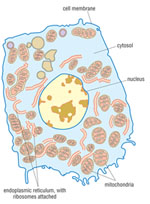3.1 Cells and cancer
As the definition of cancers in the Introduction stated, cancers are characterised by the rapid creation of abnormal cells. So we have to begin this study session by reminding you about what cells are and how new cells are created. All living organisms, including bacteria, protozoa, fungi, plants and animals, are organised into distinct functional and structural units termed cells. The outer surface of every cell is a cell membrane that separates the inside of the cell from the external environment. Inside the cell membrane is a jelly-like fluid (the cytoplasm, or cytosol in modern biology textbooks), and tiny structures with specific functions arranged in a particular way.
A diagram of a typical cell found in the human body is shown in Figure 3.1.

The largest structure in any cell is usually the nucleus, which contains most of the DNA in the cell. DNA (deoxyribonucleic acid) is a complex large chemical, which contains the genes of the individual. Genes are structures that determine what type of cells will develop, how they function, and how the cells in an organism are arranged, nourished, stimulated and protected in the body. Most human cells have one nucleus, but muscle cells have more than one and red blood cells have none at all. Other important structures in the cell create new molecules (e.g. proteins needed for cell growth) and others break down fuel molecules (e.g. glucose) absorbed from the surrounding environment. Cells would not be able to survive without generating energy from nutrients brought to them in the blood to fuel all the processes that go on inside the cell.
What is the difference between a normal cell and a cancer cell, in terms of cellular structures? The short answer is not much is different. Almost always the only important difference is that the nucleus is larger and may be somewhat irregular in cancer cells. The difference is not so much in their appearance, but in how cancer cells behave.
Learning Outcomes for Study Session 3
